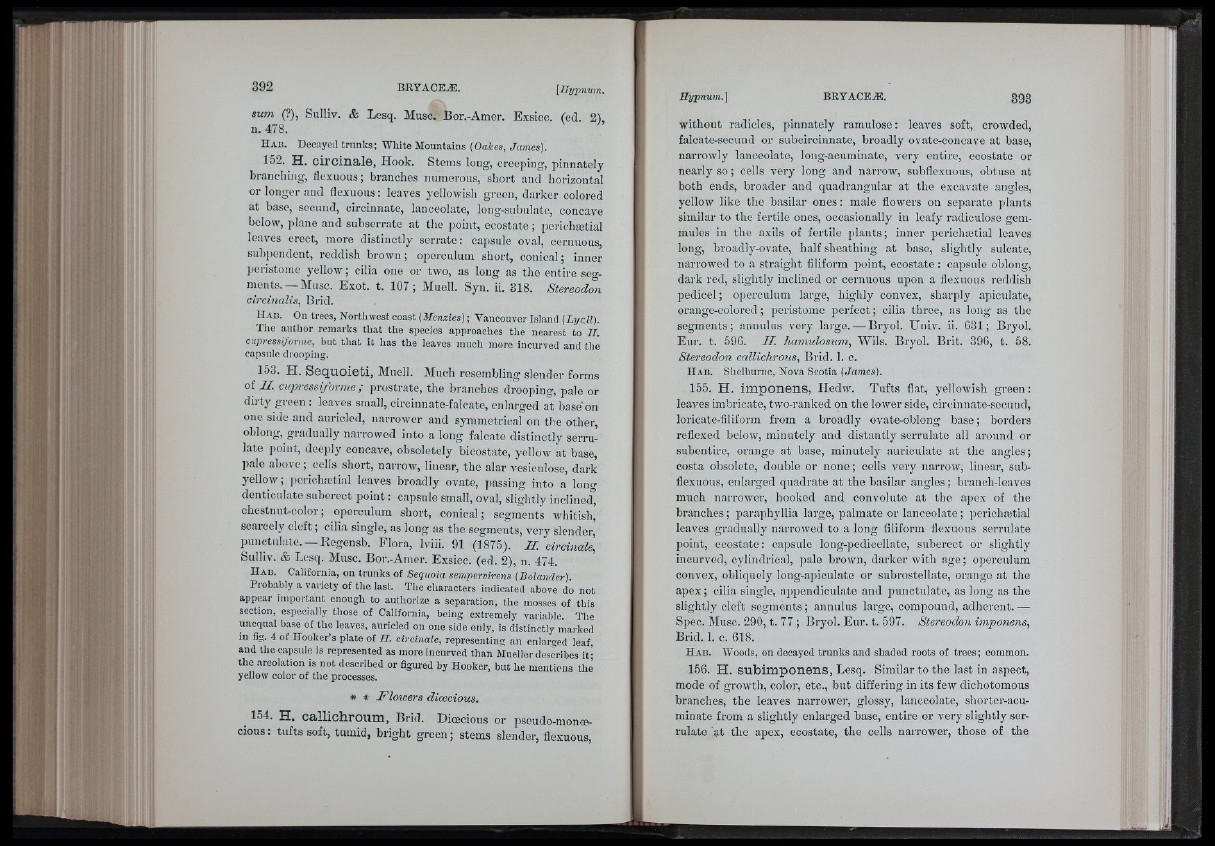
Fi'
sum (?), Sulliv. & Lesq. Musc. Bor.-Amer. Exsicc. (ed. 2),
n. 478.
H a i3. Decayed trunks; White Mountains (Oakes, James).
152. H. c irc in ale, Hook. Stems long, creeping, pinnately
branching, flexuous; branches numerous, short and horizontal
or longer and flexuous: leaves yellowish green, darker colored
at base, secund, cireinnate, lanceolate, long-subulate, concave
below, jilane and subserrate at the point, ecostate ; perichætial
loaves erect, more distinctly serrate: capsule oval, cernuous,
subpendent, reddish brown; operculum short, conical; inner
pei-istomo yellow ; cilia one or two, as long as tlie entire segments.—
Muse. Exot. t. 107; Muell. Syn. ii. 818. Stereodon
circinalis, Brid.
IIAÜ. Oil trees, Northwest coast (Menzies) ; Vancouver Island (Lyall).
T’lie author remarks that the species approaclies tlie nearest to Ih
ciiprcssiforme, but that it has the leaves much more incurved and tlie
capsule drooping.
153. il. Sequoieti, Muell. Much resembling slender forms
0ÎJ1. cupressiforme ; prostr.ate, the br.anches drooping, pale or
dirty green; leaves small, circinnate-falcate, enlai-ged .at base on
one side and auricled, narrower and symmetrical on the other,
oblong, gradually narrowed into a long falcate distinctly serrulate
point, deeply concave, obsoletely bicostate, yellow at base,
pale above ; cells short, narrow, linear, the alar vesiculose, dark
yellow; jierichætial leaves broadly ovate, passing into a long
denticulate suberect point : capsule small, oval, slightly inclined,
chestnut-color; operculum short, conical; segments whitish,
scarcely cleft ; cilia single, as long as the segments, very slender,
punctuhite. —Regensb. Flora, Iviii. 91 (1875). II. circinale,
Sulliv. & Lesq. Muse. Bor.-Amer. Exsicc. (ed. 2), n. 474.
H a u . California, on trunks of Sequoia sempervirens (Bolander)
Probably a variety of the last. Tlie eliaracters indicated above ¿o not
appear important enough to authorize a separation, tlie mosses of tliis
section, especially those of California, being extremely variable. The
unequal base of the leaves, auricled on one side only, is distinctly marked
in fig. 4 of Hooker’s plate of II. circinale, representing an enlarged leaf,
and tlie capsule is represented as more incurved than Mueller desm-ibes it^
the areolation is not described or figured by Hooker, but he mentions thè
yellow color of the processes.
* * Floioei's dioecious.
154. H, c a llichrofim, Brid. Dioecious or pseudo-monoecious:
tufts soft, tumid, bright green; stems slender, flexuous.
without radicles, pinnately ramulose : leaves soft, crowded,
falcate-secund or subcircinnate, broadly ovate-concave at base,
narrowly lanceolate, long-aouminate, very entire, ecostate or
nearly so ; cells very long and narrow, subflexuous, obtuse at
both ends, broader and quadrangular at the excavate angles,
yellow like the basilar ones : male flowers on separate plants
similar to the fertile ones, occasionally in leafy radiculose gemmules
in the axils of fertile plants; inner perichætial leaves
long, broadly-ovate, half sheathing at base, slightly sulcate,
narrowed to a straight filiform point, ecostate : capsule oblong,
dark red, slightly inclined or cernuous upon a flexuous reddish
pedicel ; operculum large, highly convex, sharply apiculate,
orange-colored ; peristome perfect ; cilia three, as long as the
segments; ammlus veiy large. — Bryol. Univ. 11. G31 ; Bryol.
Eur. t. 596. II. hamulosum, Wils. Bryol. Brit. 396, t. 58.
Stereodon callichrous, Brid. 1. c.
H a b . Shelburne, Nova Scotia (James).
155. H. imponens, Hedw. Tufts flat, yellowish green;
leaves imbricate, two-ranked on the lower side, circinnate-secund,
loricate-filiform from a broadly ovate-oblong base ; borders
reflexed below, minutely and distantly serrulate all around or
subentire, orange at base, minutely auriculate at the angles;
costa obsolete, double or none ; cells very narrow, linear, subflexuous,
enlarged quadrate at the basilar angles; branch-leaves
much narrower, hooked and convolute at the .apex of the
branches ; paraphyllia large, palmate or lanceolate ; perichætial
leaves gradually narrowed to a long filiform flexuous serrulate
point, ecostate: capsule long-pedicellate, suberect or slightly
incurved, cylindrical, pale brown, darker with age ; operculum
convex, obliquely long-apiculate or subrostellate, orange at the
apex ; cilia single, appendiculate and punctulate, as long as the
slightly cleft segments; annulus large, compound, adherent.—
Spec. Muse. 290, t. 77 ; Bryol. Eur. t. 597. Stereodon imponens,
Brid. 1. c. 618.
H a e . AToorls, on decayed trunks and shaded roots of trees; common.
156. H. su b imponens, Lesq. Similar to the last in aspect,
mode of growth, color, etc., but differing in its few dichotomous
branches, the leaves narrower, glossy, lanceolate, shorter-acuminate
from a slightly enlarged base, entire or very slightly serrulate
at the apex, ecostate, the cells narrower, those of the